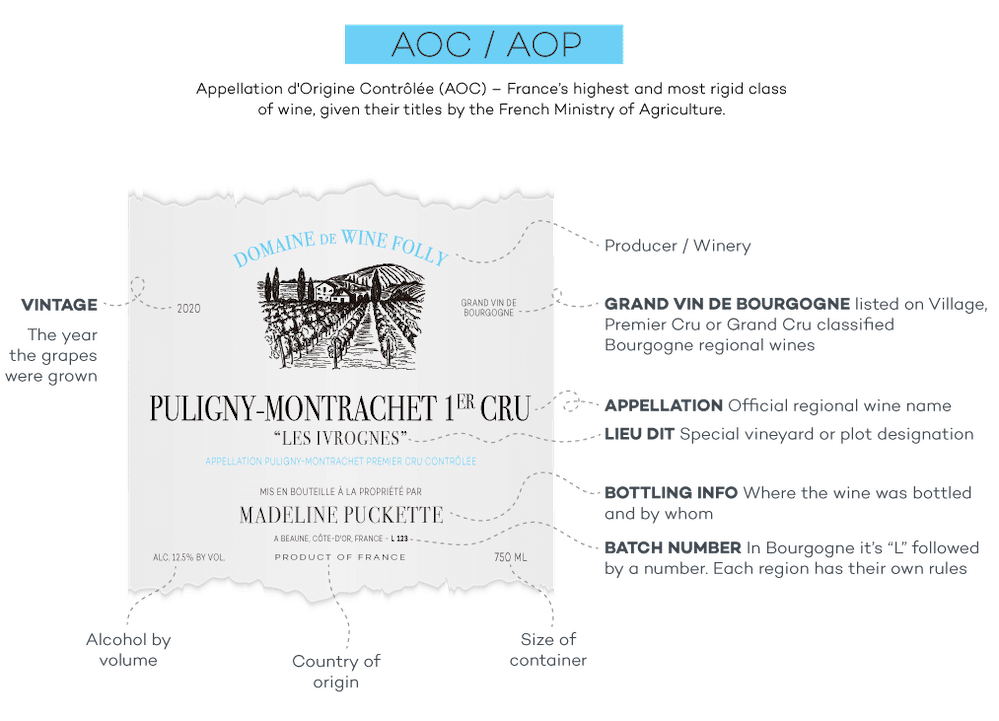When it comes to AOC wine and French classifications, it can feel really complicated really fast. But if you know some basics, you’ll find that understanding comes pretty easily. Plus, it’ll help you drink better wine!

What is AOC Wine?
Have you ever been buying wine and noticed the words AOC somewhere on the label?
AOC is short for Appellation d’Origine Contrôlée, and refers to standards set for wines made in France. There are 363 AOCs for wine and spirits in France which control everything from how the grapes are grown to what wine varieties are in the bottle.
The French wine classification correlates with the European Union’s PDO (Protected Designation of Origin) which protects all kinds of regional food specialties such as Parmigiano-Reggiano cheese in Italy.
In France, there is a governing body called the INAO: the Institut National de l’Origine et de la Qualité. This branch of the French Ministry of Agriculture ensures quality for wine, cheese, and other food products.

Designations of AOC Wine
Within the AOP itself, you’ll find several designations that reflect location and quality.
- Regional: This refers to the broadest sense of an AOC. Examples:Bordeaux, Burgundy.
- Sub-Regional: Within those regions are smaller subregions known for more specific wine or terroir. Examples: Bordeaux’s Médoc sub-region, Burgundy’s Chablis sub-region.
- Commune/Village: Narrowing further within a subregion, these areas are sometimes only a few miles in scope. Examples: Pauillac in Médoc, Côtes d’Auxerre in Chablis.
- Special Classification: An AOC might be further specified for quality at this point, indicating a Cru, which refers to a specific vineyard or group of vineyards typically recognized for quality.

Where Did the AOC Come From?
In an effort to control the reputation of wine and other cultural foods, France established the INAO in 1935. Support for the creation of the AOC itself was in large part due to winemaker Baron Pierre Le Roy, leading to the first designated AOC: Châteauneuf-du-Pape.
By 1937, the establishment of the AOC for classic winemaking regions such as Bordeaux, Burgundy, and Champagne took place, setting about standards and rules that are still in effect today.
For example, AOC laws ensure that if you buy a bottle of French wine labelled “Champagne,” you’re getting a sparkling wine made in the traditional method from the region of Champagne with Chardonnay, Meunier, and/or Pinot Noir. (And that’s just scratching the surface of standards.)

What’s an IGP?
There is another tier of French wine that’s well worth investigating called IGP wines. This classification name stands for Indication Géographique Protégéeor “Vin de Pays” as in, a “country wine.”
IGP lists 74 geographical areas and 150 unique designations. Some examples include Pays d’Oc, Comté-Tolosan, and Val de Loire.
IGP regional wines allow for more grape varieties and a less strict set of standards in the creation of said wine. That means there are fewer rules, which leads to a much greater variation in quality than one would generally see in an AOC wine. In some rare instances, producers choose this classification because their wines fall outside of the ruleset for AOC.
What’s the Difference Between AOC and IGP?
If an AOC refers to specific locations and specific rules, an IGP broadens those rules. Usually, an IGP comes from a larger area with fewer regulations on grape growing and varieties allowed. For this reason, it’s pretty common for a French IGP wine to list what grape varieties are used on the label.
For example, with a bottle of wine from the Bordeaux sub-region of Sauternes, you generally know what to expect: a sweet white wine concentrated by botrytis, made from up to three specific grapes. However, a wine from the IGP of Pays d’Oc might refer to a white, red, or rosé wine of various styles and grape varieties.
This doesn’t mean that you’ll automatically prefer a wine from an AOC over one from an IGP. Just that the standards set in the AOC are more specific.
With such selection how do you market for each consumer’s personal taste
If this guide has suggested anything to the ecommerce wine retailer, it the infinite variety of the products each of your customers needs you to nourish your relationship with them as an individual Everyone is different and, as this guide suggests, there are infinite varieties and derivations of taste.
Retailers, to maximise their returns, must ensure that the wine offered is of specific interest to each individual. This is impossible to do manually. You can’t do it for several thousand people, let alone tens of thousands.
There is software available for you to install called generative ai predictive personalisation software (GAIPPS) onto your platform, which immediately uses both the buying history of each individual, but also their impressions as they roam about your site. It identifies what each consumer’s preference is at that moment in time, and presents that wine to them, for their delection, a couple of times each month. PPS complements any other activity you do, and has the highest ROI in online marketing.
You have had to do nothing, as it is completely autonomous, and the world’s leading research companies all agree it delivers the highest return in wine ecommerce marketing. Take a free trial of GAIPPS software today, and give your customers what they want every time.
You may enjoy to read more article on wine ecommerce here.





